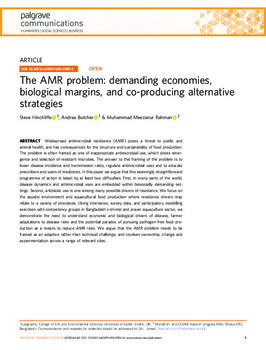The AMR problem: demanding economies, biological margins, and co-producing alternative strategies

Citation
Hinchliffe, S.; Butcher, A.; Rahman, M.M. (2018). The AMR problem: demanding economies, biological margins, and co-producing alternative strategies. Palgrave Communications, 4(1): 142
Widespread antimicrobial resistance (AMR) poses a threat to public and animal health, and has consequences for the structure and sustainability of food production. The problem is often framed as one of inappropriate antimicrobial use, which drives emergence and selection of resistant microbes. The answer to this framing of the problem is to lower disease incidence and transmission rates, regulate antimicrobial uses and to educate prescribers and users of medicines. In this paper we argue that this seemingly straightforward programme of action is beset by at least two difficulties. First, in many parts of the world, disease dynamics and antimicrobial uses are embedded within biosocially demanding settings. Second, antibiotic use is one among many possible drivers of resistance. We focus on the aquatic environment and aquacultural food production where resistance drivers may relate to a variety of processes. Using interviews, survey data, and participatory modelling exercises with competency groups in Bangladesh’s shrimp and prawn aquaculture sector, we demonstrate the need to understand economic and biological drivers of disease, farmer adaptations to disease risks and the potential paradox of pursuing pathogen-free food production as a means to reduce AMR risks. We argue that the AMR problem needs to be framed as an adaptive rather than technical challenge, and involves ownership, change and experimentation across a range of relevant sites.
Permalink
Link to PDF
Date Available
Type
Publisher
Countries
ISSN
2055-1045
Copyright
CC BY 4.0
Research Themes
Language